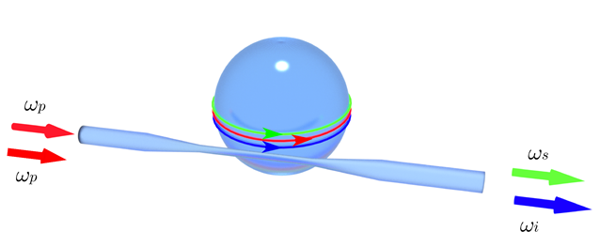Advances in quantum technologies over the past two decades have made possible an exciting breadth of applications in fields such as communications, and computation. Photon-pair generation based on the spontaneous parametric down conversion and four wave mixing processes have played an essential role in this revolution due to the ease with which the quantum entanglement characteristics of the emitted signal and idler photons may be tailored, and on account of their ability to propagate long distances either in free space or in optical fibers with minimal interaction with the environment.
However, a number of key challenges must be overcome in order for photon pair generation technology to achieve its true potential, including: i) source miniaturization enabling the eventual on-chip integration of source, optical manipulation, and detection, ii) increasing the conversion efficiency, thus permitting high-brightness photon-pair emission with the lowest possible pump power, iii) photon pair indistinguishability, including spectral factorizability, permitting photons from distinct sources to interfere, and iv) the reduction of the emission bandwidth to the MHz, or sub-MHz, level so as to be compatible with atomic electronic transitions.
The last requirement must be achieved in order to create single atom-single photon interfaces which will facilitate information transfer from photons, in the form of flying qubits, to atoms thus constituting a quantum memory. This technology is essential for the further progress of quantum information processing based on photons.
An optical platform which has the potential to simultaneously meet all of these requirements is the ultra-high Q optical microresonator. As a result of the long photon lifetimes inside the cavities, extremely high circulating intensities are possible, leading to drastically enhanced emission rates per unit pump power.
In addition, the extremely narrowband resonances lead to nonlinear optical effects occurring at very well-defined frequencies, translating into emission in the form of a single-photon frequency comb with extremely narrow emission peaks. Because cavity-enhanced photon pair generation involves emission in well-defined cavity modes, by isolating a single cavity resonance for each of the signal and idler modes, the resulting two-photon state ends up being naturally spectrally factorizable, ensuring indistinguishability. Lastly, microresonators are uniquely well-positioned to permit source integration.
The research group led by Dr. Alfred B. U'Ren from Universidad Nacional Autónoma de México (UNAM) in Mexico city, have demonstrated a submegahertz spectral width photon pair source based on fused silica microspheres. The research results are published in Photonics Research, Volume 9, No. 11, 2021 (Erasto Ortiz-Ricardo, Cesar Bertoni-Ocampo, Mónica Maldonado-Terrón, et al. Submegahertz spectral width photon pair source based on fused silica microspheres[J]. Photonics Research, 2021, 9(11): 11002237).
In this paper we present a photon-pair source based on the spontaneous four-wave mixing (SFWM) process, implemented in fused silica microspheres as the nonlinear medium, which successfully addresses many of the challenges identified above. In addition, we have presented a full theory for the SFWM process in these devices that fully takes into account all source characteristics relevant in our experiments.
We present simulations based on this theory leading to an excellent general agreement with our experimental measurements, including the Q-dependent shape and width of the single-photon frequency comb envelope. Let us note that our theory could be applied also to other types of cavities, such as microrings and microdisks. As a result of the high optical cavity Q values obtained in our microspheres, heralded single photons with spectral widths down to 366 kHz are demonstrated.
In our experiments we have used a pump centered near 1550 nm, with the signal and idler close to 1540 nm and 1560 nm, respectively. We herald a single idler-mode photon by detecting the corresponding signal photon, filtered via transmission through a wavelength division multiplexing channel of choice.
We demonstrate the extraction of the spectral profile of a single peak in the single-photon frequency comb from the Fourier transform of the experimentally-measured signal-idler time of emission difference distribution. The improvements in both device design and experimental methods which we have demonstrated have enabled the narrowest spectral width (=366kHz) to date in a heralded single photon source based on SFWM. These results represent a ~43 times improvement over the shortest bandwidth previously reported in a SFWM-based photon-pair source.

Fig.1 Photon-pair source based on a fused silica microsphere, characterized by an ultra–high quality factor.


